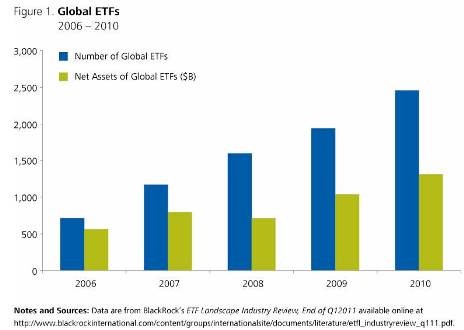What is an ETF (Exchange Traded Fund)
Post on: 30 Октябрь, 2015 No Comment

Most investors are familiar with mutual funds and index funds. In a mutual fund, investors pool their investment dollars, and fund managers decide how to invest that money. Investors are typically involved with certain aspects of the fund: strategy, what sorts of stocks or bonds it will invest in, size of firms it will invest in, etc. Fund managers take this strategy into account and make buying and selling decisions based on their investors’ goals and all available information regarding market conditions. Shares in a mutual fund, unlike typical stocks and bonds, can only be purchased at the end of a trading day.
An exchange-traded fund is different, in that its shares can be traded at any time throughout the trading day. Another key characteristic is that most exchange-traded funds are index funds. Index funds are those that are passively managed. Tthey aim to track the performance of a stock, bond, currency, or commodity index. Index funds generally provide investors with lower cost ratios, because of drastically lower costs with regards to management, accounting, marketing and distribution. Exchange-traded funds typically provide these same benefits to investors.
In addition to the benefits ETFs provide by virtue of their nature as index funds, the ability to trade ETFs throughout the trading day provide investors with freedoms typically only enjoyed by traders of individual stocks. Traders are able to purchase ETFs on margin, short sell them, and trade using stop orders and limit orders. For example, using ETFs a trader who expects the entire market to drop in price can short sell, for example, the entire S&P 500 index. Similarly, a trader who wishes to invest in the S&P but believes its current price too high can place a limit order for when the price drops. ETFs also make day trades against indexes possible. Previous to the development of ETFs, an investor could only purchase or sell shares in index funds at the end of a trading day.
The risks of owning an ETF as a long-term investment are pretty similar to those of owning a typical index fund. ETFs share the diversification provided by index funds, but you are still exposed to the general level of risk inherent in whatever market your ETF trades in. The risks of using ETFs in a short-term strategy are similar to short term strategies in similar markets.
Because most ETFs are index funds, they tend to come with low costs. However, trading an ETF will require spending whatever fee your broker charges for a trade. In other words, if your online discount broker charges $6.95 per trade, it will cost you that much to purchase a quantity of stock in an ETF. If your broker uses a flat fee, this amount matters less and less as the amount of your investment climbs. For example, let’s say that your broker charges $10 per buy and sell order. If you invested $1,000, your investment would have to appreciate by 2% just to recoup the cost of the purchase and sale. If you were to invest $10,000, your investment would have to appreciate by only .2% to recoup those same costs.
Because ETFs are publicly traded, they’re easy to own for anyone with a traditional or discount broker. If you’re interested in trading a particular index, compare the expense ratios of various ETFs that track the same index. After you know which you want to purchase, placing a sale is as easy as double-checking the trading symbol and placing an order with your broker. Of course, you should never let this convenience short change your decision making process. Consider ETFs as critically as you would any other part of your long or short term investment strategy.














